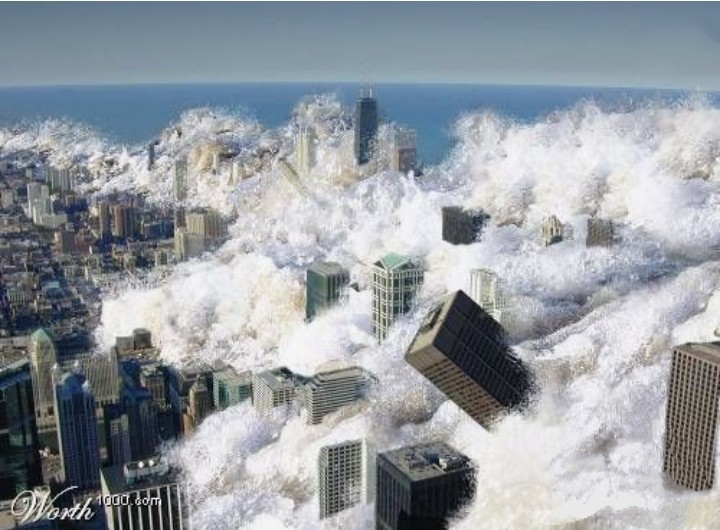Indian Ocean
INDIAN OCEAN


* Body of water between Africa, Southern Ocean, Australia and Asia
* Lies in eastern hemisphere
* World 3rd largest Ocean
* 29.8% of water on Earth surface
* Area -7,05,60,000km²
* Named after India, which makes up much of its northern border
* Known as Indian Ocean since 1515: earlier was called Eastern Ocean
* Warmest Ocean in the world - lies near equator
* Landlocked in Northern Hemisphere - does not extend to Artic waters - Closed Ocean
* Ocean with maximum negative water balance and lowest Oxygen content - grater evaporation rate than its run off or precipitation influx
* Madagascar - largest island in Indian Ocean and 4th largest in world
* 40% of worlds offshore oil production comes from Indian Ocean
Deepest Point:
* Sunda Trench ( popular name- Java Trench)
* Located - off the Southern Coast of Java * Depth -7,450 m
Delimiting of Indian Ocean:
* From Atlantic Ocean: 20° East Meridian, running south from Cape Agulhas
* From Pacific Ocean: meridian of 146° 49'E, running south from the southern most point of Tasmania
* Northern most extent: including marginal season) : 30° north in the Persian Gulf
Marginal Seas:
* Indian Ocean has some large marginal Seas
* A marginal seas is a section of an Ocean partially enclosed by an island, a peninsula, or an archipelago ( group of islands)
* Marginal Seas are shallower than the Ocean and have close proximity to land.
* Marginal Seas in Indian Ocean are extremely important for trade - provide major sea routes that cannot middle East, Africa, East Asia, Europe and the Americas.
Marginal Indian Important Seas :
* Andaman asea( Gulf of Martban)
* Bay of Bengal
* Andaman sea
* Arabian sea
*Laccadive sea
* Gulf of Oman
* Persian Gulf
*Gulf of Aden
* Red sea
* Mozambique channel
Submarine Fans:
* Submarine Fans are under water geological structures associated with large - scale sediment deposition.
* Indian Ocean contained the largest Submarine fans of the world Bengal fan and Indus fan
* The Bengal fan also known as the Ganges fan, is the largest Submarine fan on earth
* Indus fan is the second largest fan system in the world between India, and Bangladesh and Andaman Islands.
* 40% of the sediment of Indian Ocean in Indus and Ganges fans.
* Immense load of suspended sediments from rivers emptying into Indian Ocean is the highest of the three Oceans.
* Nearly half of it comes from Indian subcontinent alone.
* Wharton Basin has the oldest sediments
Ridges:
*Indian Ocean has active spreading ridges
* It includes:
- carlsberg Ridge
- chagos - Laccadive Ridge
- (central Indian Ridge) south west India R
/(South east Indian Ridge)
- Madagascar Ridge
- 90° Ridge
- Broken Ridge
Mid- Indian Ocean Ridge
* Ocean floor of Indian Ocean is dominated by the Mid- Indian Ocean Ridge/ Central Indian Ocean Ridge.
* Separates African plate from Indo- Australian plate
* The ridge from an inverted Y on the Ocean floor and subdivided by
- southeast Indian Ocean Ridge
- southwest Indian Ocean Ridge
Ninety East Ridge:
* Most striking is the aseismic ( Virtually earthquakes free) Ridge.
* Largest straight ridge - divides Indian Ocean into west and East Indian Ocean
* First discovered in 1962
* Extent between latitudes 33*S and 17*N
* Runs northward along the 90* E merridian( hence its name) from the Broken Ridge
* Total length - 5,000km average width- 200km
Rodrigues Triple Junction:
* Geologic triple junction in Southern Indian Ocean where three tectonic plates meet: African plate, into- Australian plate and Antarctic plate.
- Central Indian Ridge: including the Carls berg Ridge, separating African plate from Indian plate.
* South west Indian Ridge, separating African plate from Antarctic plate.
* Southeast Indian Ridge separating Australian plate from Antarctic plate.
Important Straits:
* Sea lanes in the Indian Ocean are considered among the most strategically important lanes for the world Trade.
" More than 80% of the worlds seaborne oil trade is through Indian Ocean and it's vital choke points.
* Of which 40% passing the strait of Hormuz
*35% passes through strait of Malacca
*8% through Bab el- mandab strait.
Indian Ocean Garbage Patch:
* An Indian Ocean GARBAGE PATCH Ride the southern Indian Ocean Gyre( any large system of circulating Ocean current is called a Gyre)
* This Vortex of plastic garbage constantly circulates the Ocean from Australia to Africa, down the Mozambique channel, and back to Australia in a period of six years.
* Plastic in it break down to small particles to constituent polymers.
Flora and Fauna:
* Coral Reefs, sea grass beds, and mangrove forests are the most productive ecosystems of the Indian Ocean.
* 50% of worlds mangroves in the Indian Ocean
* Warm Ocean less phytoplankton (except along the northern fringes and in a few scattered spots) limited sea life.
* Endangered species include dugong, whales, seablions, turtles.
* The western Indian Ocean hosts one of the largest concentration of phytoplankton blooms in summer, due to the strong monsoon winds.
* A study on the phytoplankton changes in the Indian Ocean indicates a decline of up to 20% in the marine plankton in the Indian Ocean, during the past six decades.
Natural Disaster:
* Two of the most devastating natural disasters.
- 2004: Tsunami - killed 2,28,000 people.
- cyclone Nargis - Myanmar in 2008 ( Killed 138,300 people)








Comments
Post a Comment